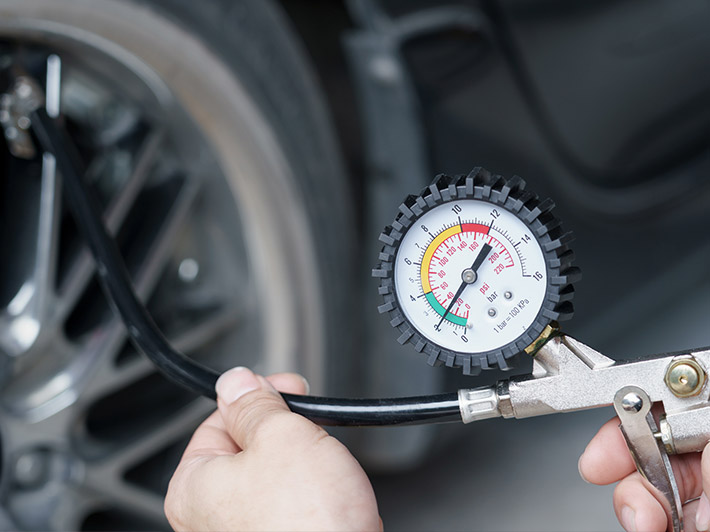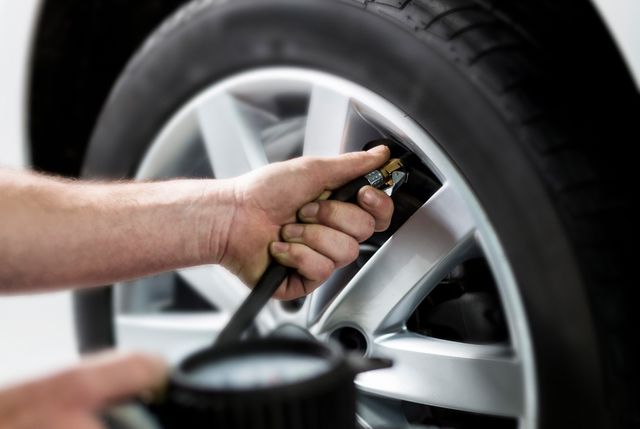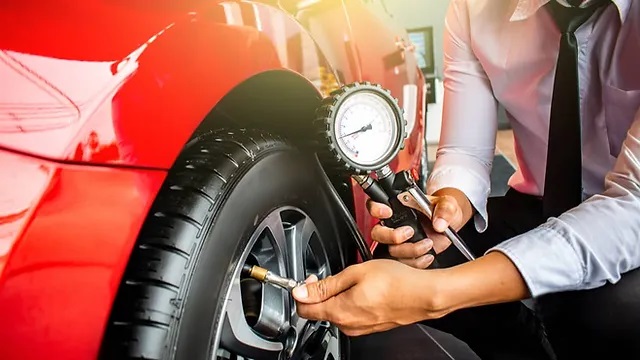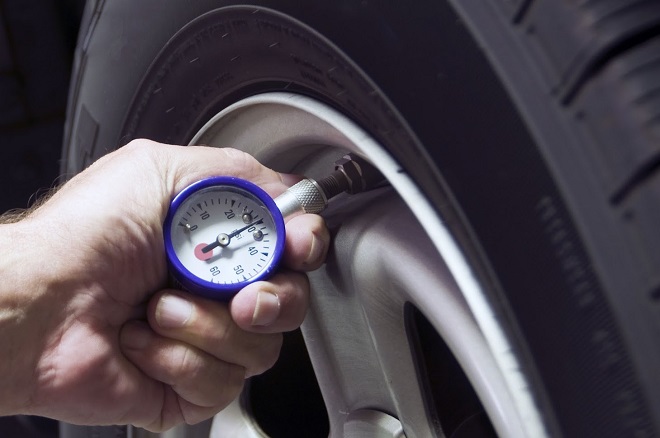TL;DR: The ideal tire pressure varies based on vehicle specifications and conditions, with 40 PSI not being a one-size-fits-all answer. Always refer to manufacturer recommendations and adjust for load and seasonal changes to ensure optimal performance and safety.Ah, the world of cars. Where we debate over manual versus automatic, diesel versus electric, and whether that ‘limited edition’ really is that limited. But amidst these epic debates, there’s one question, seemingly simple, that stumps many a car enthusiast: How much air does my tire really need?
It sounds straightforward, but ask around, and you’ll find answers as varied as car models themselves. Today, we’re tackling that question head-on and addressing the buzz around the magical 40 PSI. Is it the tire pressure unicorn we’ve all been searching for? Buckle up; it’s going to be a bumpy (or should I say, well-inflated) ride!
Understanding Tire Pressure Basics
You ever stand there at the gas station, hose in hand, and wonder if there’s some ancient automotive council that decided 40 psi is the sacred number of tire inflation? I’ve spent many a night, probably more than any sane person should admit, pondering that very question.

First things first, for those of you not down with the jargon, PSI stands for “Pounds per Square Inch”. This is basically a measure of how much air pressure you’re stuffing inside that round rubber doughnut your car rides on.
But why does it matter? It’s all about balance, my friends. Too little pressure and your tire is as saggy as an old recliner, meaning more rolling resistance and reduced fuel efficiency. Too much, and it’s like riding on a set of granite Frisbees, with a reduced contact patch compromising your grip.
But let’s hone in on that ubiquitous 40 PSI. Historically, most passenger cars have recommendations somewhere between 30 and 35 PSI. Trucks, with their load-carrying aspirations, might go higher. But here’s the kicker – 40 PSI isn’t the golden number for all. Some believe it’s the optimal middle ground, offering a solid mix of fuel efficiency and wear resistance. But just as you wouldn’t wear your grandpa’s shoes to a marathon (unless you’re into that sort of challenge), not every car will benefit from being inflated to a straight 40 PSI.
Here’s where the sleep-deprived scientists come in. They’ve run the numbers, done the tests, and generally agreed that tire pressures should be tailored to the car. And there’s me thinking I could just pump and go! Silly Wilfred.
The Deal with 40 PSI
There I was, sipping my morning coffee, when I thought, “Why 40 PSI? Who deemed it the tire-pressure royalty?” And like any normal person after their third cup of joe, I went down the rabbit hole. So, put on your detective caps, folks; it’s story time.
Back in the days when car radios were a luxury and seatbelts were, well, optional, tire technology wasn’t quite where it is today. The tires were bias-ply, and their recommended pressures were quite a bit lower. But as technology evolved, along came radials and with them, increased pressure recommendations. The reason? Radials had different construction, better heat dissipation, and generally could handle – and often required – more PSI.

Now, most passenger vehicles today come with a sticker – not the cool superhero kind, but the very practical one inside the driver’s door. This label tells you the carmaker’s recommended PSI, typically floating between 30 and 35 PSI. But then, there’s that audacious 40 PSI. It’s like that overachiever cousin who always has something to prove at family gatherings. Some folks think it’s the sweet spot for maximizing fuel efficiency and tire lifespan. A little like choosing to run in sneakers instead of sandals – you can do both, but one’s bound to be more efficient.
However, there’s no universal “one-size-fits-all” for tire pressure. Thinking every car should be at 40 PSI is like assuming everyone should wear size 10 shoes. Spoiler alert: I’ve tried, and it’s not pretty.
In the grand scheme of things, 40 PSI isn’t some magical figure bestowed upon us by the tire gods. It’s just a number that floats around and might be right for some vehicles, but not for all. So next time you’re pumping air and that guy next to you swears by 40 PSI, just remember: Your car, your rules. Unless, of course, he’s driving a space shuttle. Then maybe, just maybe, take his advice.
Benefits of Higher PSI
Alright, time to talk perks of living on the higher side of PSI town. You see, there’s a reason some folks pump their tires up like they’re prepping for a space launch. And no, it’s not just to give their tires that overly buffed look.

1. Improved Fuel Economy: Higher tire pressure means less tire surface squishing against the road. In layman’s terms? Less drag. It’s the same reason swimmers shave their legs; less resistance, more speed. With your tires, this translates to better fuel efficiency. I mean, who wouldn’t want a few extra miles per gallon? Especially when gas prices seem to be playing some cruel, upward-only limbo game.
2. Slightly Longer Tire Lifespan: Over-inflating a bit can, in some cases, reduce the rate at which your tires wear down. It’s like buying shoes a half-size too big – might not be a perfect fit, but hey, they’ll last longer!
3. The “Free Massage”: This one’s a personal favorite. Pump those babies up to a higher PSI, and suddenly every tiny road pebble feels like a sizeable speed bump. It’s akin to getting a free massage every time you drive. Although, to be honest, it’s more like one of those very aggressive Swedish massages where you’re not sure if you’re being relaxed or pummeled.
But it’s not all sunshine and rainbows in High PSI Land. Just like that extra-strong coffee that wakes you up but also makes your hands shake like you’re playing maracas, more isn’t always better. And while it might sound fun in theory to bounce around town like you’re on a trampoline, the reality can be a bit…jarring.
Stay with me, dear reader. In the next section, we dive into the potential pitfalls of treating your tires like overinflated balloons. And trust me, it’s not just about the unexpected “lift-off.”
The Drawbacks of Too Much Air
Now, I can already hear some of you saying, “Wilfred, more PSI sounds like the answer to my fuel-saving prayers!” But hold onto your lug nuts, folks. Before you turn your tires into miniature Hindenburgs, let’s chat about the pitfalls of treating them like they’re competing in a high-pressure cooking show.
1. Reduced Handling and Grip: Imagine wearing stilettos to a mud-wrestling match. Sounds silly, right? Well, overinflating your tires is a tad similar. The increased pressure reduces the tire’s contact patch with the road. Fewer rubbery bits touching the tarmac means less grip. So, while you may save a penny at the pump, you’ll potentially pay for it when that sharp turn on a rainy day feels more like an ice-skating rink.
2. Increased Center Tread Wear: Pump those tires up too much, and they start to bulge, like a gym buff flexing his pecs. This “bodybuilder effect” means the center of the tire wears out faster than the edges. So instead of a nice, even wear pattern, you get a bald strip down the middle. Not exactly the mohawk look most of us are going for.
3. A Less Forgiving Ride: Remember that “free massage” I mentioned? Well, too much pressure and that massage can turn from a gentle Swedish session to feeling like you’re being body-slammed by a sumo wrestler every time you hit a pebble. The ride becomes harsher and less comfortable. It’s like swapping out your car’s suspension for a set of wooden planks.
4. Risk of Blowouts: And here’s the real kicker. Overinflated tires are more susceptible to damage from potholes, debris, and other road hazards. It’s like blowing up a balloon too much – sure, it might float higher for a bit, but poke it with a pin and BOOM! Same with your tires. A sharp object or a nasty bump, and you could be on the roadside wishing you hadn’t tried to set a new PSI record.
So, while shooting for that magical 40 PSI might seem like a shortcut to automotive nirvana, remember that balance is key. It’s like dieting – sure, kale smoothies might be good, but nobody wants to live on them alone.
Next up, we’ll delve into the art of finding the Goldilocks zone for your ride. Not too high, not too low – just right.
Finding the Right Tire Pressure for Your Car
Alright, champs, we’ve traversed the peaks and valleys of the PSI landscape. Now it’s time to find that sweet spot, the optimal PSI that’ll make your tires and your car hum in harmonious unity. And no, it doesn’t involve any magical incantations or tire-whispering (though if you’ve found that to work, do let me know).

1. Check the Manufacturer’s Recommendation: This ain’t a mere suggestion; it’s the automotive gospel. Hidden inside your car’s driver’s door or sometimes in the manual (yes, that book you stashed in your glovebox and never opened) lies the tire pressure treasure map. Here, automakers list the recommended PSI for both front and rear tires. Spoiler: it’s often not a sexy round number like 40, but trust me, it’s been rigorously tested for YOUR specific ride.
2. Adjust for Load: Heading out on a road trip? Packing the trunk till it looks ready to burst? Well, more weight might mean a need for a smidge more PSI. But go easy; we aren’t looking to recreate the bouncing ball scene from a cartoon.
3. Seasonal Changes: Ah, Mother Nature. While she blesses us with sun, snow, and everything in between, she also plays merry havoc with tire pressure. Cold air contracts, which means a drop in PSI during winter. Conversely, hot air expands, potentially adding PSI in the summertime. A rule of thumb? For every 10°F change in air temperature, tire pressure will change about 1 PSI. So, keep that gauge handy when seasons shift.
4. Trust Your Instincts (and the Tech): Modern cars come with tire pressure monitoring systems (TPMS). It’s that little light on your dashboard that looks suspiciously like a flat tire. If it lights up, it’s not complimenting your driving; it’s suggesting a tire check.
5. The Goldilocks Test: Just like our fairy-tale heroine, it’s about finding what feels “just right.” Drive around with the recommended PSI and then tweak it a little if needed, observing the ride comfort, fuel efficiency, and handling.
Conclusion
In conclusion, the pursuit of the perfect PSI isn’t a mere numbers game; it’s a dance between science, circumstance, and sensibility. And remember, folks, a tire pressure gauge can save you more than just a few dollars; it can provide peace of mind. And isn’t that the best kind of ride?